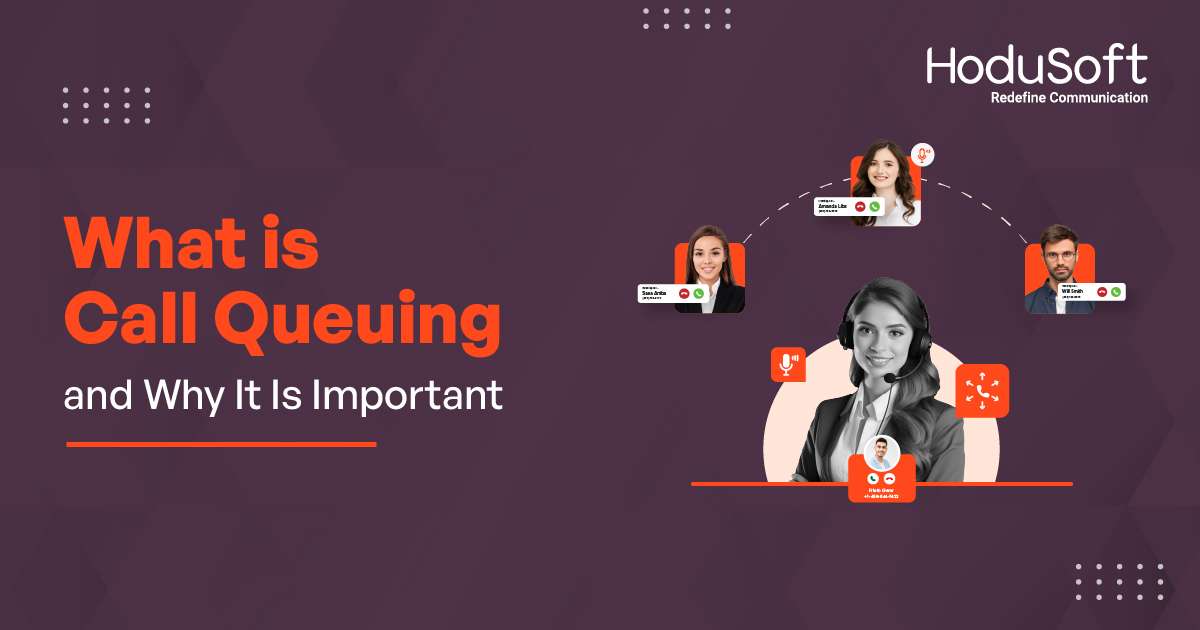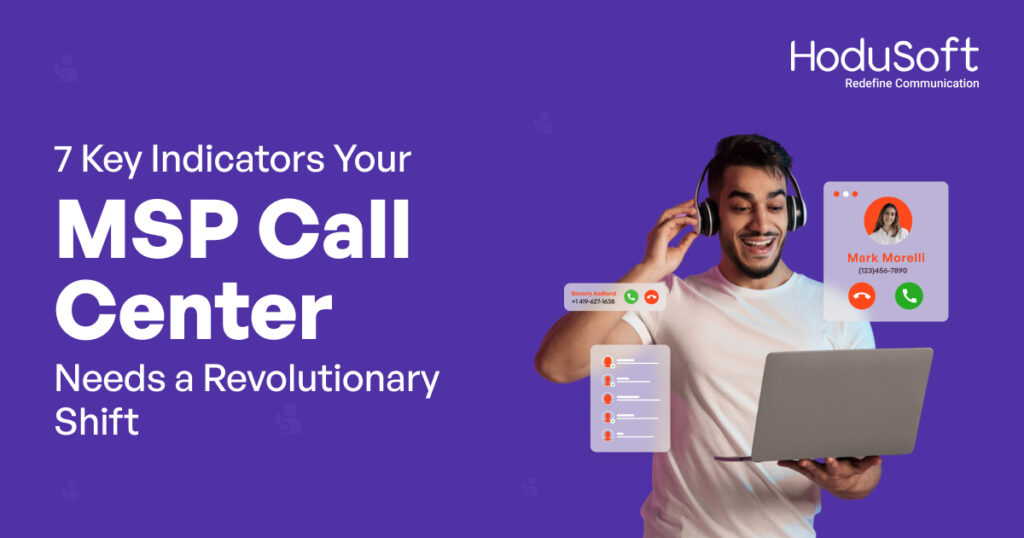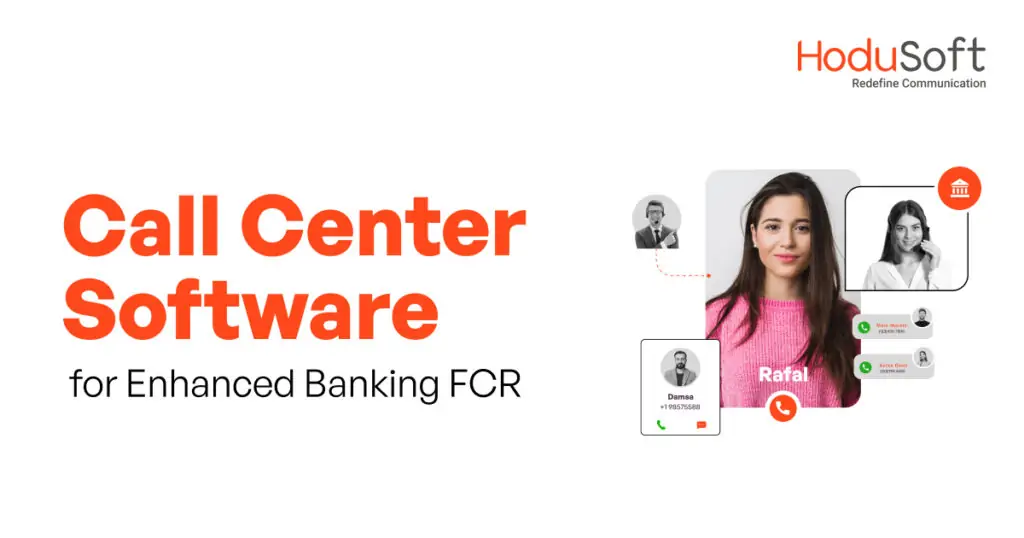What Is Call Queuing and Why It Is Important?
If you are an owner of an inbound call center (or contact center) then you must know how important it is to answer all incoming calls as soon as possible. What’s even more important is to ensure the calls reach the right departments and agents.
But when callers dial your customer service number, only a small fraction of them get to speak with a live agent instantly. The rest have to wait for a while till the ongoing calls end and after that only they can ask their queries or tell their problems to the agent.
In the fast-paced world, however, using the traditional method to keep callers waiting is a recipe for disaster. Many of them don’t have a few seconds to waste and it can be an excruciatingly frustrating experience for them if they are kept in the dark about how many callers are ahead of them and how long they have to wait for their turn.
Once callers are annoyed with the wait time and the lack of information, they not only abandon the call but they are extremely likely to not call again. In worst cases, they may stop doing business altogether and switch to a competitor.
That sounds like a huge price a business is likely to pay if it doesn’t manage the waiting calls properly. The best way to do that is by using a call queue management system, which is extremely effective in managing calls on waiting.
This blog post discusses the call queue system in great detail including how it works, benefits, as well as strategies to enhance call queuing. Read on and thank us later.
What is a call queue?
A call queue, also known as a waiting queue or phone queue, is a system in call centers or contact centers that places callers into a virtual queue, based on pre-established criteria, until the right (most suitable) agent is available to answer their call.
The contemporary call queue system is engineered to queue incoming calls as per their priority, purpose, and type. It is used to efficiently manage incoming phone calls and ensures that calls are handled on a first-come, first-served basis. It’s exactly similar to queuing up at an ATM, inquiry counter, or ticket counter. But here instead of standing in a line, the callers are put on hold.
History of the Contemporary Call Queue System
Danish mathematician, statistician, and engineer Agner Krarup Erlan is considered the father of the modern call queuing system. He used his model—the Erlang model of the queuing theory—to describe the Copenhagen telephone exchange.
His ideas found applications in a wide range of sectors, most notably in the telecom industry, which kept on working on the model to enhance call queuing. Over the years many utility companies started using call queuing to manage seasonal peaks in their call center traffic and unexpected traffic surge because of service interruptions or inclement weather.
Customer care organizations use call queuing to enhance service levels and increase customer loyalty. The main aim of queue management is to minimize call transfers, reduce the hold time, as well as optimize the call handle time to resolve an issue.
How does a Call Queue Work?
A call queue efficiently manages incoming calls by placing them in a line, ensuring they are answered in the order they were received, minimizing hold times, and enhancing customer service. Here is how a call queue works:
1. IVR
The first step to a call queue starts immediately after a caller interacts with an Interactive Voice Response (IVR) system, which collects all relevant information such as the reason for the call, department sought, language preferences, etc. After the caller enters the given options, they are directed to the department they selected.
2. Call arrival
When a call center’s (or customer service) department receives more incoming calls than its agents are available to answer them, the calls get directed to the call queue system through a call routing mechanism, a toll-free number, or a dedicated phone line.
The first call to arrive goes to the front of the queue while the successive calls line up after it. The call queue also considers the time of the call concerning the preset business schedule, which is divided into:
- During or after business hours
- On a weekday or over the weekend
- On a holiday
3. Pre-recorded greetings and messages
Most businesses use pre-recorded messages to greet and engage callers. Warm greetings and informative messages are much better than a normal phone ring. Organizations can customize their greetings and messages as per the time of the day as well as special offerings, promotions, or general information.
Some sophisticated call queue systems inform estimated wait time as well as position updates before connecting callers to an agent.
Trivia: If you are planning to use pre-recorded messages, then you may want to steer clear of the phrase “Dear customer, your call is important to us…” for it’s the most irritating phrase in the customer service industry. In a survey, more than one-third of respondents voted it as the most annoying.
4. Availability of agents
The call queue system monitors the availability of agents and customer service representatives. This is where a sophisticated Automatic Call Distribution (ACD) proves to be extremely useful. As the name suggests, the feature receives every inbound call and distributes it to an available agent. ACD follows the First In, First Out method. In it, the first caller in the queue is sent to an available agent.
5. Call routing
Call routing is the most important step of the call queue process, as it determines which specific agent the caller will speak to. Here are some of the most important call-routing strategies:
- Skills-based routing: This ensures that agents with relevant skills and experience receive specific calls.
- Sequential routing: This ensures that all incoming calls follow a list-based routing strategy.
- Time-based routing: This makes sure agents working in different geographical locations receive calls based on their working hours and availability.
- Least occupied routing: This optimizes employee productivity by transferring the call to an agent who has not spoken to a customer for a long time.
6. Advanced call handling and overflow handling
Advanced call handling typically follows a two-step process. The incoming call goes to an interactive voice response tool (IVR), where answers to a series of automated questions help determine the caller’s purpose.
If the call queue becomes too long or if wait times exceed a certain threshold, the system might employ overflow handling mechanisms. This could involve routing calls to other available agents or departments, sending calls to voicemail, or offering a call-back option.
Supervisors or administrators can monitor the call queue system, track statistics, and make adjustments as needed. This might involve reassigning agents, adjusting routing rules, or updating hold messages.
7. Monitoring call queue analytics
Supervisors and managers must leverage real-time and historical call queue analytics to optimize the present calls on the queue. The dashboard provides critical details such as average call handling times, service level, call volume counts, and more such key metrics that help reduce wait times and prevent agents from getting overburdened.
Live analytics provide valuable insights into the number of callers in the queue, average hold time, the number of agents currently speaking to a customer, available agents, and even queueing data by department.
Benefits of Call Queue Management
Would it surprise you if you came to know that customer-facing businesses that leverage sophisticated call-queuing management systems enjoy many more benefits than their counterparts that don’t use call-queuing systems? Call queue management provides a wide range of benefits ranging from:
1. Reduces customers’ wait time and call abandonment rates
In a fast-paced world, people want fast service and responses more than ever before. Previously, waiting for a couple of minutes for a call to get through to customer service representatives wasn’t a big deal. But now, waiting for only a minute can be difficult for many callers.
A Velaro survey found that over 60 percent of respondents don’t like to be put on hold for a minute. Another study found that 13 percent of respondents will hang up if they are kept waiting just for a few seconds. As per recent research, almost a third of callers who abandon calls will never contact the business again.
2. Enhances FCR
When customers call your customer service number, they expect to get their issues resolved and queries answered on the very first instance. If that doesn’t happen, then it can lead to customer dissatisfaction and frustration. As per a recent study, 93 percent of customers expect first contact resolution (FCR), which makes the industry average of 70-80 percent FCR rate inadequate.
A SQM Group study found that every time a customer makes a follow-up call, it results in a 15 percent drop in satisfaction scores. That’s why you must aim to achieve as high an FCR rate as possible. By optimizing call queuing, you can enhance your FCR by leaps and bounds. Proper call queuing management ensures that all callers get connected to the right agents. It also equips agents with relevant customer information such as their preferred language, department sought, and the type of problem they’re facing.
3. Efficient agent utilization
For all call centers, the agent utilization rate is an important metric. As the name suggests, the agent utilization rate is the percentage of time a customer support representative spends on calls and other call-related tasks.
The rate is calculated by dividing the total time spent on calls by the total time spent on shift and multiplying it by a hundred. For a majority of businesses, an agent utilization rate of 60-80 percent is good.
However, optimized call queuing can enhance agent utilization rate. By matching available agents with incoming calls, well-managed call queue systems ensure efficient agent utilization. This leads to even distribution of calls among available agents and no calls are left unanswered.
4. Improved customer experience
When customers don’t have to wait for a long time and have their issues resolved and queries answered on the very first call, then they are bound to have a superior experience. As call queue management enhances FCR, it plays a huge role in customer satisfaction. Various types of research reveal that just a one percent increase in FCR results in a one percent increase in customer satisfaction score.
Well-managed call queuing prioritizes calls based on their arrival time, ensuring that customers are served on a first-come, first-served basis. Providing customers with estimated wait times helps manage their expectations and allows them to decide whether to wait or opt for an alternative contact method.
5. Enhances employee satisfaction and productivity
When optimized call queue management enhances customer experience and satisfaction, how can it not increase employee satisfaction and productivity? When agents don’t deal with angry and frustrated customers, they are more likely to be more productive and satisfied with their job.
Moreover, agents will have time to provide more detailed customer service, deliver fine-tuned sales pitches, and work on the parts of their jobs they enjoy the most. This all adds up to higher productivity levels, employee satisfaction, and employee retention rates.
How to Enhance Call Queue Management
Here are some ways customer-facing businesses can enhance call queue management:
1. Use different routing strategies
Using just one strategy for business phone numbers and extensions is similar to having a single lane on a busy highway. However, using multiple routing strategies provides businesses with different options, adaptability, and scalability to efficiently manage call volumes.
That’s why businesses must adopt different routing strategies not only for different departments but also based on agent schedules, call volume, VIP customer status, and more.
Organizations must invest quality time to study which routing strategies work for particular situations and ensure that they use the strategies to keep pace with business growth. To give an example, time-based routing is great for a billing department whereas skills-based routing is perfect for a customer service department.
2. Create ring groups
Call groups (also known as ring groups) are groups of agent phone numbers/extensions pre-configured to ring based on preconfigured settings. Call groups are especially helpful for larger companies or departments, as you can set specific agents to take specific types of calls based on things like the time of day, the agent’s strongest skills, or even agent preference.
Admins can configure call groups so that all phone numbers in the group ring simultaneously or one after the other and can even set the specific number of rings before the caller is sent to the next group member. The goal is to make it more likely that the caller will connect with a live agent on their first call.
3. Provide omnichannel support
In the digital age, a majority of customers would prefer contacting a business over live chat, instant messages (such as WhatsApp), and even social media than dialing the customer service number and waiting for the call to be received by an agent. That’s why you must focus on providing omnichannel support so that customers can connect with you using different channels.
In an omnichannel contact center, agents can handle multiple customer communications simultaneously, which they can’t do in a normal call center. For instance, an agent can reply to a customer query on WhatsApp as well as handle a website chat without going from one tab to the other or getting distracted. But it’s not possible to do that in a regular call.
4. Use Interactive Voice Response (IVR)
IVR is extremely useful for managing call queues. To begin with, IVR enables customers to quickly reach the right department and agent, which minimizes unnecessary transfers and hold times.
IVR streamlines the call routing process by allowing callers to self-select the purpose of their call. This ensures that calls are directed to the most appropriate agent or department, reducing the need for multiple call transfers and minimizing caller frustration.
Moreover, IVR provides callers with a wide range of options and essential information (such as call-back requests, self-service options, estimated wait times, and more) as they wait in the queue. By offering these choices, IVR empowers callers and improves their overall experience, reducing perceived wait times and enhancing customer satisfaction.
5. Provide self-service options
In the present time, more people prefer availing self-service to speaking with customer service representatives. That’s because a majority of them don’t want to wait in line for the call to get connected to a live agent.
As per a study, more than two-thirds of customers preferred self-service over speaking with a customer service representative. Providing self-service options is one of the best ways to manage call queues.
Develop self-service portals or knowledge bases where customers can find answers to common questions without needing to contact an agent.
Features such as Voice Response (IVR) systems, AI-powered chatbots, and more will enable customers to perform simple tasks or find accurate and quick answers to common queries without the help of an agent.
6. Provide a back option
A poll that surveyed more than 1,100 people revealed that almost two-thirds of respondents preferred callback to hold. Reliable call center software includes a call-back feature, which can help you manage high call volumes and reduce on-hold time.
Some call queues offer a call-back option. To reduce your average hold time, leverage the call-back option. Callers can choose to receive a call back from an agent when it’s their turn, rather than waiting on hold. This can be more convenient for callers who don’t want to stay on hold.
All said and done,
To put it simply, a sophisticated call queue management system in call centers or contact centers places callers into a virtual queue and makes customers’ waiting time more bearable.
Selecting the right call queuing management feature can be a massive game-changer for customer-facing businesses that receive a massive volume of incoming calls.
At HoduSoft, we have equipped our cutting-edge HoduCC – contact center software and HoduPBX – IP PBX software with high-quality call queuing features. If you want to know more about our call queuing management system, contact us today for a free demo.



